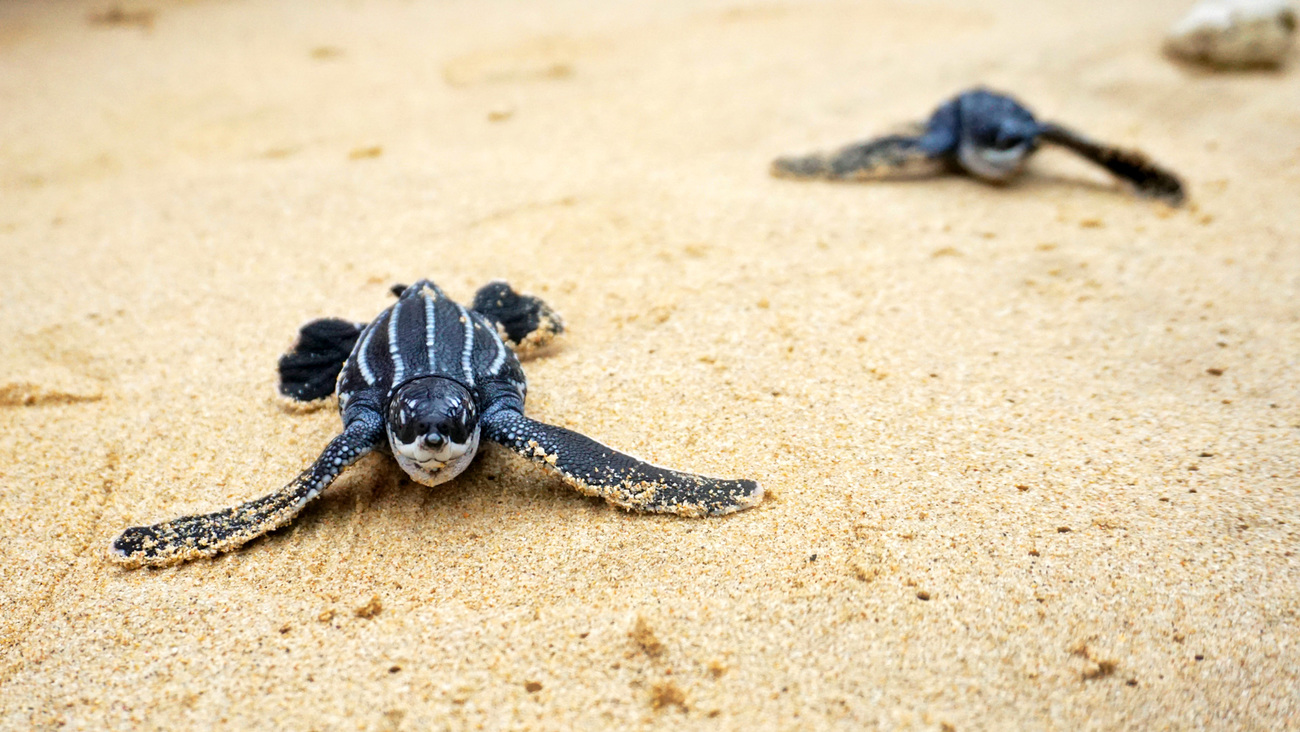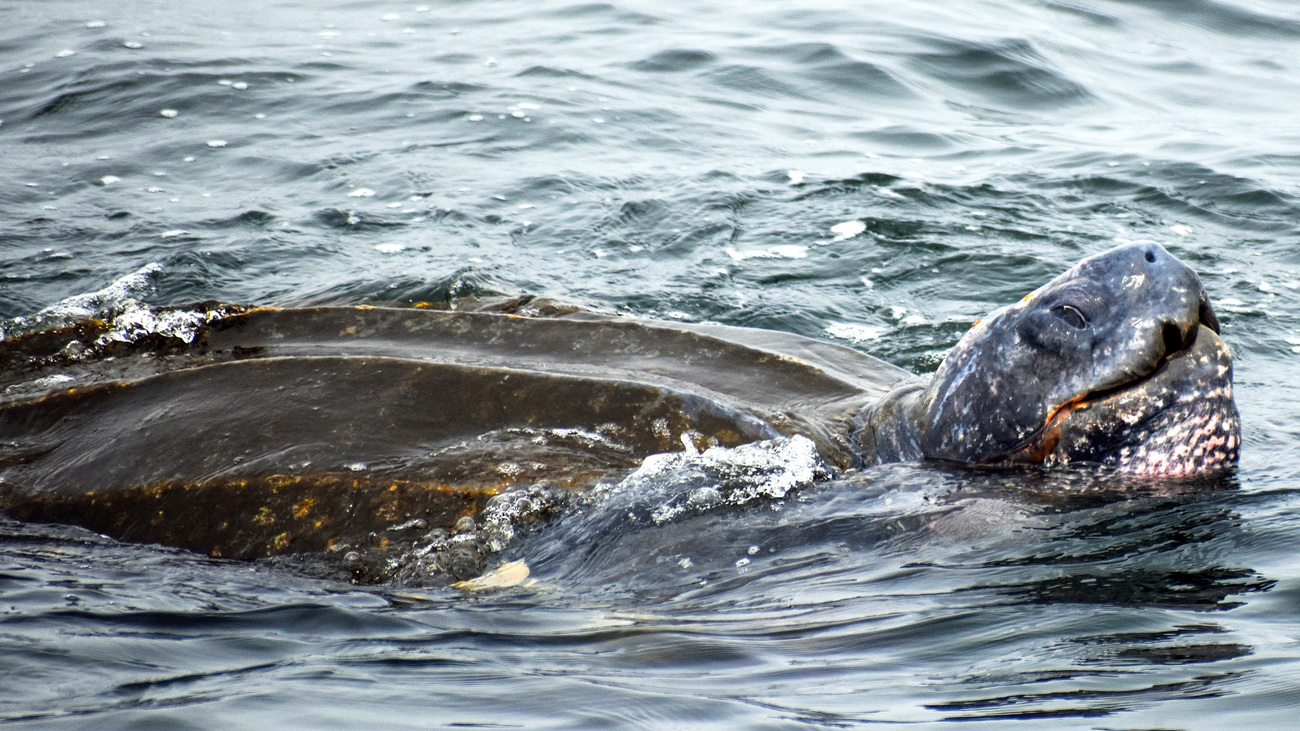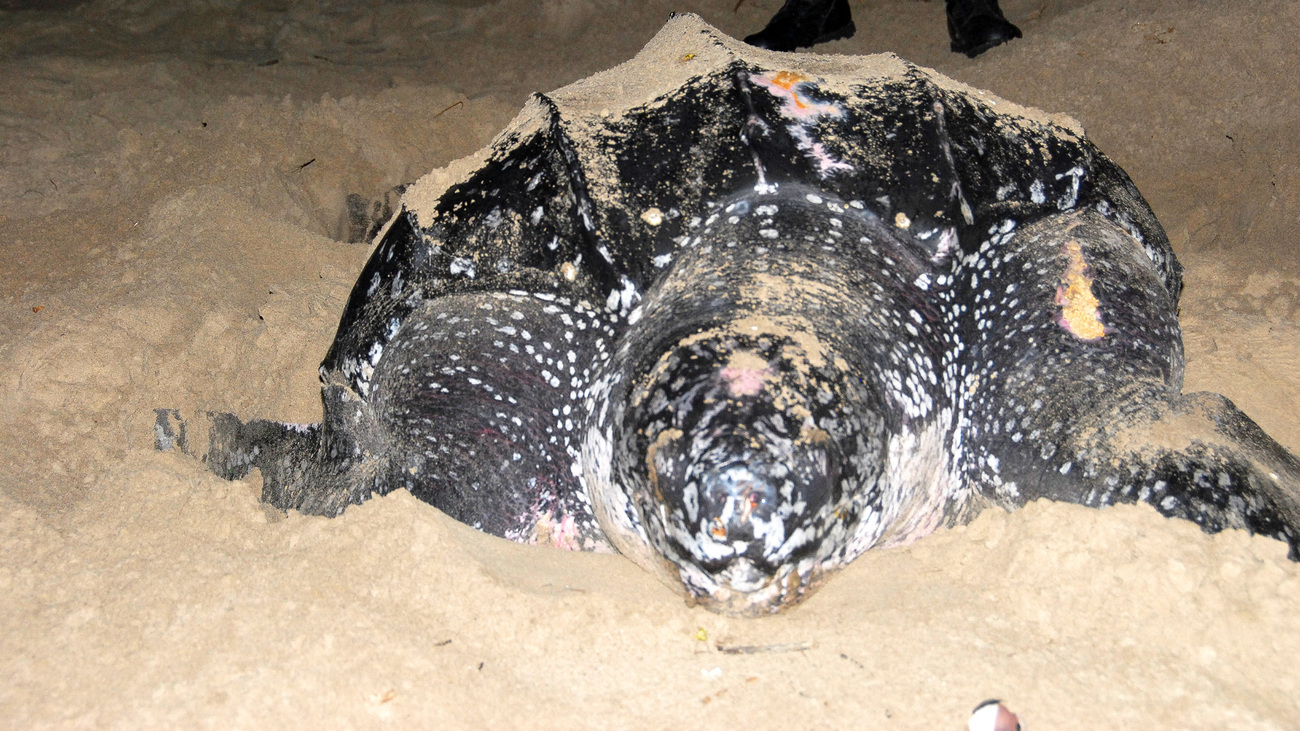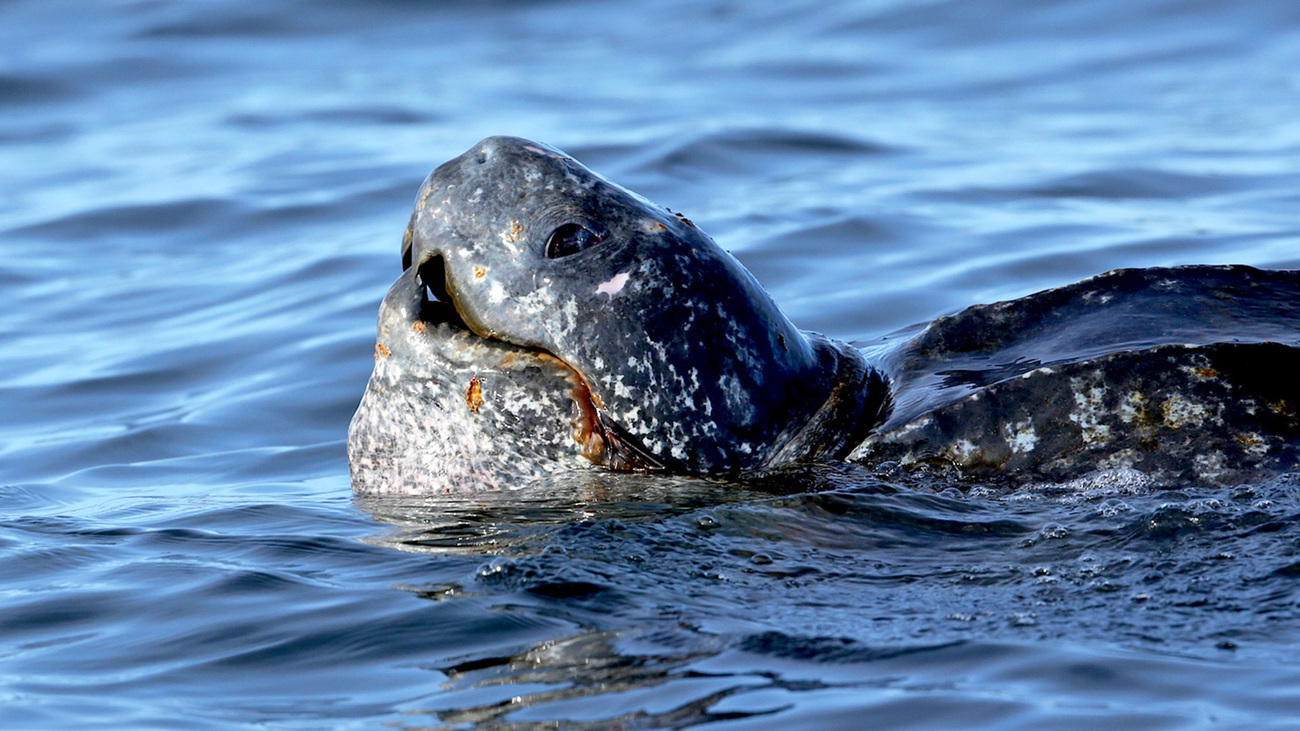Leatherback turtles
Leatherback turtles (Dermochelys coriacea) belong to the reptile family Chelonioidea. They are commonly referred to simply as leatherbacks. These turtles have a long history and have been a part of our planet’s rich biodiversity for about 100 million years.
Leatherback turtles have a number of interesting physical attributes and are quite distinct from other sea turtle species. One of their most notable characteristics is their shell. Unlike other species of turtle that have hard, bony carapaces, leatherbacks have a shell that is soft and flexible. This unique feature is actually where leatherbacks get their name, as their skin resembles tough, leathery material.
The leatherback shell isn’t just any ordinary covering. It’s composed of cartilage-like tissues, and it’s not only different in terms of structure but also functionality. Having a softer shell allows leatherbacks to dive deeper and withstand pressure changes better than turtles with harder shells.
As well as that, these turtles also lack scales entirely. This is another unique trait separating them from other similar species. While you might assume that this leaves them vulnerable in comparison to tougher-shelled turtles, their long evolution has had many adaptations to help with survival.
Another notable physical characteristic of leatherbacks is their size. They’re the largest living turtle species on Earth and can grow up to two metres (6.5 feet) long. Leatherbacks can weigh up to 1,000 kilograms (2,200 pounds).
This incredible size is accompanied by a long lifespan—leatherback turtles can live for up to 50 years in the wild. This longevity gives them an extended period of potential reproduction, which is crucial considering the various existential threats they face. The importance of this longevity is evidenced by the fact that sexual maturity among leatherbacks isn’t immediate. It takes between nine and 20 years before they are ready for procreation.
Once they have reached sexual maturity, female leatherbacks are ready to begin laying eggs. Their nesting process is an incredibly fascinating aspect of their reproductive behaviour and involves female leatherbacks journeying back to the same beach where they were born. Despite spending most of their lives in water, leatherback turtles return to land for this part of their life cycle, and this homing instinct is a critical part of the leatherback’s reproduction.
During nesting season, a female leatherback can nest between five and seven times, and each nest she creates becomes home to approximately 100 eggs. Another unique trait of their reproductive cycle is that their fertility does not remain constant—each successive round of egg-laying within one season results in fewer eggs than the last.
The final step in this process is incubation. The eggs are left to incubate under the warm sand for about 60-70 days. Not all eggs in a nest will hatch, and of those that do, not all hatchlings will make it to the sea. It’s estimated that as little as one in 1,000 hatchlings will survive until adulthood.
The leatherback turtles that do make it to adulthood have a vast geographical footprint, spanning both tropical and mild waters all over the world. They populate all three of the Atlantic, Pacific, and Indian Oceans, demonstrating an impressive ability to adapt to different environments. Their distribution is so wide that you could spot them in northern Alaska or as far south as New Zealand.
The main source of food for leatherback turtles is jellyfish. Their jaws and throat have evolved special adaptations that help them to efficiently attack and consume gelatinous prey. Unlike other sea turtles, leatherback jaws aren’t equipped for chewing or tearing. Instead, they’ve evolved to be suitable for a diet of soft-bodied animals.
The mouth and throat of leatherbacks have evolved in a similar manner, and are lined with sharp spikes. These allow the turtles to latch onto jellyfish and other slippery, soft prey.
Another interesting evolutionary adaptation of leatherbacks that sets them apart from other turtle species is their ability to survive in colder seas. Unlike many others who prefer warmer waters, the leatherback has insulating fat layers and a unique circulatory system that allows it to function well even in very cold ocean waters.
As well as thriving in both warm and cold water, leatherbacks have a remarkable ability to dive into deep water. In fact, their ability to plunge up to 1,200 metres (nearly 4,000 feet) below the surface is a feat that is unmatched by any other turtle species and shows their incredible resistance to pressure. These deep dives aren’t brief, either. Leatherbacks can stay submerged for up to 85 minutes at a time before they need to surface for air. This prolonged diving time allows them to hunt more effectively in deeper parts of the ocean where there is a higher density of prey.
What is a leatherback turtle’s scientific name?
The scientific name of the leatherback turtle is Dermochelys coriacea. This Latin term traces back to its unique physical attributes, setting it apart from other sea turtles. Dermochelys means ‘skin-turtle’, which is a nod to their distinctive leathery shell, while coriacea translates to ‘made of leather’.
Are leatherback turtles endangered?
Leatherback turtles are classified as vulnerable by the IUCN. Though they are not yet considered endangered, this classification means that there is still a high risk of leatherbacks facing extinction in the wild.
Where do leatherback turtles live?
Leatherback turtles have an amazing ability to adapt and live in different aquatic environments all over the world. They inhabit both mild and tropical oceans, and this includes everything from the open high seas to shallow intertidal areas.
Leatherbacks actually boast the widest global distribution of all reptile species, potentially surpassing any vertebrate on Earth. They are found in every ocean around the world except for the polar seas. They can frequently be found in the Pacific, Atlantic, and Indian Oceans, in addition to the Mediterranean Sea.
Their distribution is so wide that they generally travel 5,950 kilometres each way (about 3,700 miles) between their breeding and feeding areas. They have been known to venture as far north as Canada, Alaska, and Norway and as far south as New Zealand and South America.
Threats
Human activity and habitat destruction are the main threats faced by leatherback turtles and are the reason for their vulnerable status.

Human activity
Leatherback turtles often find themselves becoming unintentional victims of the fishing industry. They frequently get caught in nets—making them bycatch—which often results in the tragic fate of drowning. They also fall victim to vessel strikes.
Nesting beaches present their own set of dangers. Coastal development is rapidly destroying the natural habitats on which these turtles rely for nesting and survival. Egg harvesting is also an issue.
Even discounting habitat destruction and predation, very few leatherback hatchlings will survive until adulthood. It’s estimated that for every 1,000 hatchlings born, only one will make it to adulthood, and this startling statistic is further exacerbated by human activity. Additional dangers like entanglement in discarded fishing gear or vessel strikes can worsen their chances.
Another significant threat comes from pollution—specifically, plastic debris floating in the ocean. Leatherbacks primarily eat jellyfish, and when floating underwater, plastic bags look similar. This leads to leatherbacks mistakenly ingesting plastic, which can often prove fatal.
Beyond plastic debris, chemical pollution and other toxic substances that are dumped at sea also pose a threat to leatherbacks. The foraging habits of these turtles often expose them to these substances either directly or through consuming prey that have ingested them.
Given their wide distribution, some regions in the world have more stable populations than others. While the populations found in Atlantic regions appear to be stable or even possibly increasing, the leatherback population in the Pacific does not fare as well. In this region, coastal development and other human activities are severely impacting leatherback turtles.
Habitat destruction
The habitats of leatherback turtles are being affected in several ways. Starting with the impact tied directly to humans, nesting habitats are often destroyed due to construction and land development. Illegal egg harvesting is also a major issue.
Land development on the coast is a particularly big problem. Hatchlings instinctively head from their nest towards the sea upon birth, and artificial lights in newly developed coastal areas can disorient them. This leads them away from the water and into potential danger.
Many of these coastal developments have led to increased tourism, which also impacts turtles. Nighttime activities on the beach that involve loud music or bonfires can disturb nesting females and deter them from laying eggs, while increased marine traffic from coastal tourism presents yet another threat.
Climate change also impacts these delicate ecosystems. Rising temperatures can alter the sand conditions that are needed for successful nesting and incubation. Given the turtles’ already extremely low rates of survival, this has the potential to impact the species’ survival.
As well as altering their ecosystems, climate change could impact the natural predators of leatherbacks. Both killer whales and tiger sharks have been known to hunt leatherbacks, and this adds another layer of complexity to their struggle for survival.
FAQs
What do leatherback turtles eat?
Leatherback turtles are omnivores, but they predominantly prefer to eat jellyfish.
How big are leatherback turtles?
Leatherback turtles can grow up to two metres (seven feet) in length and weigh as much as 1,000 kilograms (2,200 pounds).
Where do leatherback turtles live?
Leatherback turtles have an amazing ability to adapt and live in different marine environments all over the world. They inhabit both mild and tropical oceans, and this includes everything from the open high seas to shallow intertidal areas.
They are found in every ocean around the world except for the polar seas. They have been known to venture as far north as Canada, Alaska, and Norway and as far south as New Zealand and South America.

Why are leatherback turtles endangered?
Leatherback turtles are classed as vulnerable thanks to the number of threats they face, including habitat destruction, climate change, and human activity, including vessel strikes, pollution, entanglement, and egg harvesting. A combination of all these factors has led to leatherbacks becoming vulnerable.
Do leatherback turtles have teeth?
Leatherbacks don’t have teeth in the traditional sense. While they don’t have the typical crushing plates possessed by other sea turtles, they do have pointed cusps and sharp jaws that make them adept at consuming soft-bodied prey like jellyfish. Their mouths and throats also feature backwards-pointing spines to help them hold onto gelatinous prey.
Our work
IFAW’s dedicated team of conservationists, policy experts, and animal rescue specialists spans the globe. We partner with local communities, organisations, and governments to safeguard wildlife.
In 2021, IFAW’s rescue team helped respond to the stranding of a leatherback turtle on Cape Cod. The turtle was successfully rescued, evaluated, and fitted with a satellite tag to track its movements before being released back into the ocean.
In 2023, following Hurricane Otis, IFAW deployed a disaster response team to Mexico. At the request of state authorities, the team visited numerous leatherback turtle nesting sites to evaluate the situation and make recommendations on how to protect their nesting sites, many of which were severely impacted by the storm.

How can you help?
Leatherback turtles are primarily threatened by human activity. Reducing plastic use is one way to help leatherbacks and other sea turtles. Being mindful of their nesting habitats and refraining from disturbing mothers, eggs, and hatchlings will also help protect this species.
IFAW is working to protect marine species around the world. Learn more about our marine conservation program and our current projects.
